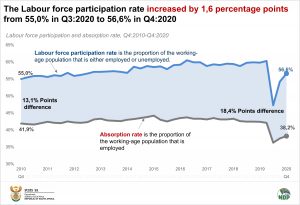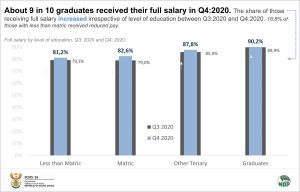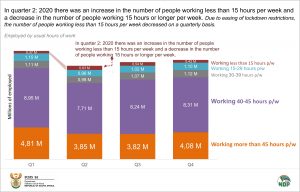More people participate in the South African labour market in the 4th quarter of 2020
According to the Quarterly Labour Force Survey (QLFS), there was an increase of 333 000 in the number of employed persons, an increase of 701 000 in the number of unemployed persons and a decrease of 890 000 in the number of people who are out of the labour force, in the 4th quarter of 2020 compared to the previous quarter. These changes resulted in increases in all key labour market rates. The unemployment rate increased from 30,8% in quarter 3 of 2020 to 32,5% in quarter 4 of 2020, the highest unemployment rate recorded since the start of the QLFS in 2008. The absorption rate (employment-to-population ratio) increased from 37,5% to 38,2% and the labour force participation rate increased from 54,2% to 56,6% during this period, indicating that more people are participating in the labour market.
When the national lockdown started, there were fewer people working and they consisted mainly of essential workers. Some people worked from home; some had reduced hours of work and some had reduced salaries. In the 4th quarter of 2020, there was a shift in the number of people working from home with more people returning to their usual place of work. Of the 15,0 million persons who were employed in quarter 4:2020, about eight in ten (78,3%) were expected to work during the national lockdown by the companies/organisations they work for. Those who actually worked were predominately men in most industries, except in the Community and social services industry and Private households, where the majority were women. About nine out of ten people employed within the Construction industry who worked during the lockdown, were men.
The proportion of those who worked from home decreased from 10,9% in quarter 3:2020 to 8,0% in quarter 4:2020. This is possibly a result of lockdown restrictions being relaxed in quarter 4, making it possible for more people to work from their usual place of work rather than working from home. Between the two quarters the share of those who received a full salary also increased, irrespective of education level, as depicted in the figure below, possibly as a result of longer hours being worked than in the previous quarter.
In quarter 2:2020 there was an increase in the number of people working less than 15 hours per week and a decrease in the number of people working 15 hours or longer per week. Due to easing of lockdown restrictions, the number of people working less than 15 hours per week decreased on a quarterly basis while the number of people working 15 hours or longer per week increased on a quarterly basis.
As a result of the lockdown restrictions in the 4th quarter of 2020, Stats SA continued to collect data telephonically, instead of the usual face-to-face interviews. As such, data could not be collected from the full sample but only from households for which contact numbers were available. The bias brought about by this has been adjusted for, and the details on how the adjustment was done are contained in the report.
For more information, download the full report here.




